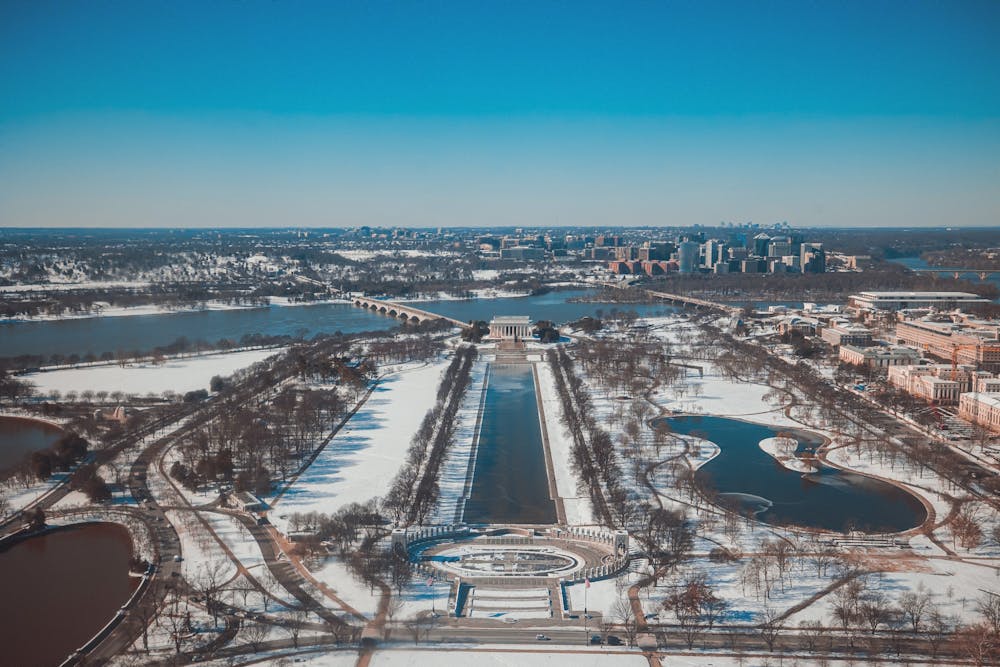On Monday, Jan. 15, the District had its first “snow day” of the year, with more possibly in tow.
D.C. public schools canceled classes, as did American University and George Washington University. Flights arriving at Reagan National Airport were heavily delayed, and non-essential federal offices closed as the city saw about four inches of snow for the first time in two years, according to NBC Washington.
With another University closure on Jan. 19, the sudden winter weather prompted Washingtonians and out-of-state residents alike to wonder — “why now?”
“I didn’t expect to see this much snow in D.C.,” Emma Roos, a freshman in the School of International Service, said. “Coming from Texas, I definitely figured there would be more snow and colder temperatures, but not by this much.”
January is consistently one of the coldest months in D.C., but the reason for the sudden influx of snow goes deeper than the calendar month. This year brought in a strong jet stream over southern Canada, as well as an El Niño — or ENSO (El Niño-Southern Oscillation) — weather pattern.
The National Weather Service’s Climate Prediction Center describes this phenomenon as when the equatorial Pacific ocean experiences warmer-than-average winter temperatures and altered wind patterns, often occurring once every four years.
Typically, in an El Niño year, the mid-Atlantic and southeastern United States experience wetter winters while the west coast stays dry. The recent arctic blast further exacerbates the severity of these wintry events.
In a statement released on Jan. 18, D.C. Mayor Muriel Bowser declared a Cold Weather Emergency through Sunday, Jan. 21, urging residents to stay inside and take precautions against the wave of below-freezing temperatures. The highest temperature on Jan. 19 only reached 27 degrees, one of the coldest days D.C. has seen in a year.
Climate change also plays a part in this phenomenon.
The abundance of greenhouse gasses from human-generated pollution creates a warmer atmospheric environment, capturing significantly more moisture, according to NASA. Once exposed to cold temperatures, this can create the moderate-to-heavy snow that blanketed the District.
In 2022, The Washington Post observed warming trends based on statistics from the National Weather Service, saying that milder winter temperatures and springlike thunderstorms would become the norm for the area.
According to Climate Central, winters are getting about 3.8 degrees Fahrenheit warmer each year, which creates a reserve of moisture that can easily freeze when introduced to frigid temperatures, thus creating heavier snow.
These storms, which dumped an additional 3.7 inches of snow as of Jan. 19 to top off Jan.15’s four, caused another wave of travel and municipal disruptions, including some on campus.
Amishai Goodman-Goldstein, a freshman in the School of Public Affairs, noticed that there was “quite a bit of ice all around, and more concerningly, large patches of black ice on campus [walkways].”
Echoing many other students, Goodman-Goldstein continued by stating that “anticipation is half the battle” when dealing with and preparing for unique weather events.
However, this year’s El Niño is not done just yet. Washingtonians can expect a relatively temperate rest of the winter with temperatures around the 40 to 50 degree range, echoing Punxsutawney Phil’s prediction, but may potentially see more snow mid-month when January’s phenomenon is expected to make an icy return.
This article was edited by Clair Sapilewski, Sara Winick and Abigail Pritchard. Copy editing done by Luna Jinks, Isabelle Kravis and Olivia Citarella.





